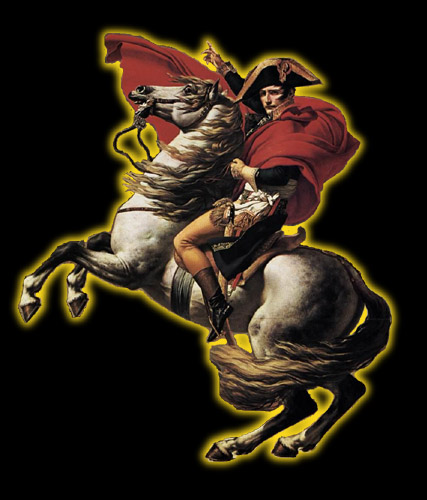
Antique prints of Napoleon

CLICK HERE
to enter our online gallery of antique napoleonic prints.

Portrait of Napoleon
French Empire : Coronation of Napoleon I and Napoleonic Wars
Napoleon faced royalist and Jacobin plots as France's ruler, including the Conspiration des poignards (Dagger plot) in October 1800 and the Plot of the Rue Saint-Nicaise (also known as the infernal machine) two months later. In January 1804, his police uncovered an assassination plot against him which involved Moreau and which was ostensibly sponsored by the Bourbon former rulers of France. On the advice of Talleyrand, Napoleon ordered the kidnapping of Louis Antoine, Duke of Enghien, in violation of neighbouring Baden's sovereignty. After a secret trial the Duke was executed, even though he had not been involved in the plot.
The Coronation of Napoleon by Jacques-Louis David in 1804
Napoleon used the plot to justify the re-creation of a hereditary monarchy in France, with himself as emperor, as a Bourbon restoration would be more difficult if the Bonapartist succession was entrenched in the constitution. Napoleon was elected as "Emperor of the French" in a plebiscite held in November. As before, this vote was implausibly lopsided, with 99.93 percent officially voting yes. He was crowned by Pope Pius VII as Napoleon I, on 2 December 1804 at Notre Dame de Paris and then crowned Joséphine Empress. The story that Napoleon seized the crown out of the hands of Pope Pius VII during the ceremony to avoid his subjugation to the authority of the pontiff is apocryphal; the coronation procedure had been agreed in advance. Ludwig van Beethoven, a long-time admirer, was disappointed at this turn towards imperialism and scratched his dedication to Napoleon from his 3rd Symphony. At Milan Cathedral on 26 May 1805, Napoleon was crowned King of Italy with the Iron Crown of Lombardy. He created eighteen Marshals of the Empire from amongst his top generals, to secure the allegiance of the army.
War of the Third Coalition
Napoleon at the Battle of Austerlitz, by François Gérard 1805. The Battle of Austerlitz, also known as the Battle of the Three Emperors, was Napoleon's greatest victory, where the French Empire effectively crushed the Third Coalition. Great Britain broke the Peace of Amiens and declared war on France in May 1803. Napoleon set up a camp at Boulogne-sur-Mer to prepare for an invasion of Britain. By 1805, Britain had convinced Austria and Russia to join a Third Coalition against France. Napoleon knew the French fleet could not defeat the Royal Navy in a head-to-head battle and planned to lure it away from the English Channel.
The French Navy would escape from the British blockades of Toulon and Brest and threaten to attack the West Indies, thus drawing off the British defence of the Western Approaches, in the hope a Franco-Spanish fleet could take control of the channel long enough for French armies to cross from Boulogne and invade England.[78] However, after defeat at the naval Battle of Cape Finisterre in July 1805 and Admiral Villeneuve's retreat to Cádiz, invasion was never again a realistic option for Napoleon.
As the Austrian army marched on Bavaria, he called the invasion of Britain off and ordered the army stationed at Boulogne, his Grande Armée, to march to Germany secretly in a turning movement—the Ulm Campaign. This encircled the Austrian forces about to attack France and severed their lines of communication. On 20 October 1805, the French captured 30,000 prisoners at Ulm, though the next day Britain's victory at the Battle of Trafalgar meant the Royal Navy gained control of the seas.
Six weeks later, on the first anniversary of his coronation, Napoleon defeated Austria and Russia at Austerlitz. This ended the Third Coalition, and he commissioned the Arc de Triomphe to commemorate the victory. Austria had to concede territory; the Peace of Pressburg led to the dissolution of the Holy Roman Empire and creation of the Confederation of the Rhine with Napoleon named as its Protector.
Napoleon would go on to say, "The battle of Austerlitz is the finest of all I have fought." Frank McLynn suggests Napoleon was so successful at Austerlitz he lost touch with reality, and what used to be French foreign policy became a "personal Napoleonic one". Vincent Cronin disagrees, stating Napoleon was not overly ambitious for himself, that "he embodied the ambitions of thirty million Frenchmen".
Middle-Eastern alliances
group of men, some wearing beards and turbans, are in a room with a large painting on the wall, they look towards a doorway wear a man in military uniform including white johphurs (Napoleon) looks back at them and has his right hand in his waistcoat.
The Treaties of Tilsit: Napoleon meeting with Alexander I of Russia on a raft in the middle of the Neman River The Fourth Coalition was assembled in 1806, and Napoleon defeated Prussia at the Battle of Jena-Auerstedt in October. He marched against advancing Russian armies through Poland and was involved in the bloody stalemate of the Battle of Eylau on 6 February 1807. After a decisive victory at Friedland, he signed the Treaties of Tilsit; one with Tsar Alexander I of Russia which divided the continent between the two powers; the other with Prussia which stripped that country of half its territory. Napoleon placed puppet rulers on the thrones of German states, including his brother Jérôme as king of the new Kingdom of Westphalia. In the French-controlled part of Poland, he established the Duchy of Warsaw with King Frederick Augustus I of Saxony as ruler.[88] With his Milan and Berlin Decrees, Napoleon attempted to enforce a Europe-wide commercial boycott of Britain called the Continental System. This act of economic warfare did not succeed, as it encouraged British merchants to smuggle into continental Europe, and Napoleon's exclusively land-based customs enforcers could not stop them.
Peninsular War
The Persian Envoy Mirza Mohammed Reza-Qazvini meets with Napoleon I at Finckenstein Palace, 27 April 1807, by François Mulard Even after the failed campaign in Egypt, Napoleon continued to entertain a grand scheme to establish a French presence in the Middle East. An alliance with Middle-Eastern powers would have the strategic advantage of pressuring Russia on its southern border. From 1803, Napoleon went to considerable lengths to try to convince the Ottoman Empire to fight against Russia in the Balkans and join his anti-Russian coalition. Napoleon sent General Horace Sebastiani as envoy extraordinary, promising to help the Ottoman Empire recover lost territories. In February 1806, following Napoleon's victory at Austerlitz and the ensuing dismemberment of the Habsburg Empire, the Ottoman Emperor Selim III finally recognised Napoleon as Emperor, formally opting for an alliance with France "our sincere and natural ally", and war with Russia and England. A Franco-Persian alliance was also formed, from 1807 to 1809, between Napoleon and the Persian Empire of Fat′h-Ali Shah Qajar, against Russia and Great Britain. The alliance ended when France allied with Russia and turned its focus to European campaigns. War of the Fourth Coalition Main article: War of the Fourth Coalition The former Spanish king was dethroned by Napoleon who put his own brother on the throne. Spaniards revolted. Thompson says the Spanish revolt was, "a reaction against new institutions and ideas, a movement for loyalty to the old order: to the hereditary crown of the Most Catholic kings, which Napoleon, an excommunicated enemy of the Pope, had put on the head of a Frenchman; to the Catholic Church persecuted by republicans who had desecrated churches, murdered priests, and enforced a "loi des cultes"; and to local and provincial rights and privileges threatened by an efficiently centralized government. The peninsular campaign in Spain proved a major disaster for France. Napoleon did well in when he was in direct charge, but that followed severe losses, and was followed by worse losses. Spain proved to be a major, long-term drain on money, manpower and prestige. Historian David Gates called it the "Spanish ulcer." Portugal defied the Continental System, so in 1807 Napoleon invaded with the support of Spain. Under the pretext of a reinforcement of the Franco-Spanish army occupying Portugal, Napoleon invaded Spain as well, replaced Charles IV with his brother Joseph and placed his brother-in-law Joachim Murat in Joseph's stead at Naples. This led to resistance from the Spanish army and civilians in the Dos de Mayo Uprising.
Joseph Bonaparte, Napoleon's brother, as King of Spain
In Spain, Napoleon faced a new type of war, termed a guerrilla war, in which the local population, inspired by religion and patriotism, took up arms. The French had to contend not only with regular armies, but also attacks by guerrillas using ambushes, sabotage and armed uprisings. Vicious reprisals by the French only escalated the hatreds and attacks. Following a French retreat from much of the country, and the surrender of Dupont's French army of 18,000 men, Napoleon took personal command and defeated the Spanish Army. He retook Madrid, then outmanoeuvred a British army sent to support the Spanish and drove it to the coast. Before the Spanish population had been fully subdued, Austria again threatened war, and Napoleon returned to France. The costly and often brutal Peninsular War continued in Napoleon's absence. Although Napoleon left 300,000 of his finest troops to battle Spanish guerrillas as well as British and Portuguese forces commanded by Arthur Wellesley, 1st Duke of Wellington, French control over the peninsula again deteriorated. France lost the Peninsular War; Napoleon realized it had been a disaster for his cause, writing later, "That unfortunate war destroyed me....All the circumstances of my disasters are bound up in that fatal knot."